What To Know About Budgerigar (Budgie) Nesting Behaviors
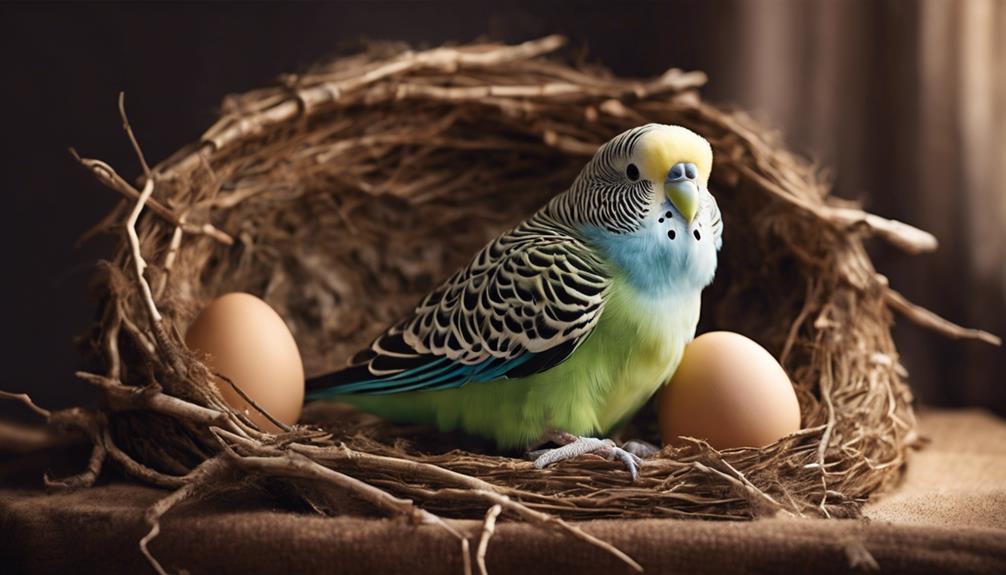
Budgerigars, also known as budgies, are small parrots that are popular as pets due to their playful and social nature. One interesting behavior exhibited by budgerigars is their nesting habits. In the wild, budgies nest in tree hollows, but in captivity, they will often use a nesting box provided by their owner. It is important to understand these nesting behaviors to ensure the health and well-being of your pet budgie.
Tips for creating a suitable nesting environment for your budgerigar include providing a nesting box that is the appropriate size and material. The box should be placed high up in the cage to mimic the height of a tree hollow. Additionally, providing nesting materials such as shredded paper or straw can encourage your budgie to build a nest. Monitoring your budgie's behavior and providing a quiet and stress-free environment can also help support successful nesting. Understanding and accommodating your budgerigar's nesting behaviors can lead to a happy and healthy pet bird.
Budgerigar Nesting Instincts
Budgerigars exhibit strong nesting instincts, displaying complex behaviors that are vital for their survival and reproduction. These small parrots, native to Australia, have intricate nesting habits that are fascinating to observe. Breeding behavior in budgerigars is a well-coordinated process involving both male and female birds.
When preparing to nest, budgerigars engage in various activities such as exploring potential nesting sites, gathering nesting materials like twigs, leaves, and feathers, and meticulously constructing their nests. The female budgerigar plays a significant role in the nest-building process, often inspecting the nest site and making adjustments to ensure it meets her standards.
During the breeding season, male budgerigars display courtship behaviors to attract females. This includes singing, dancing, and offering regurgitated food to the female. Once a pair has bonded, they work together to build a suitable nest where the female will lay her eggs. Understanding these nesting instincts and breeding behaviors is crucial for creating a conducive environment for budgerigars to thrive in captivity.
Types of Budgie Nests
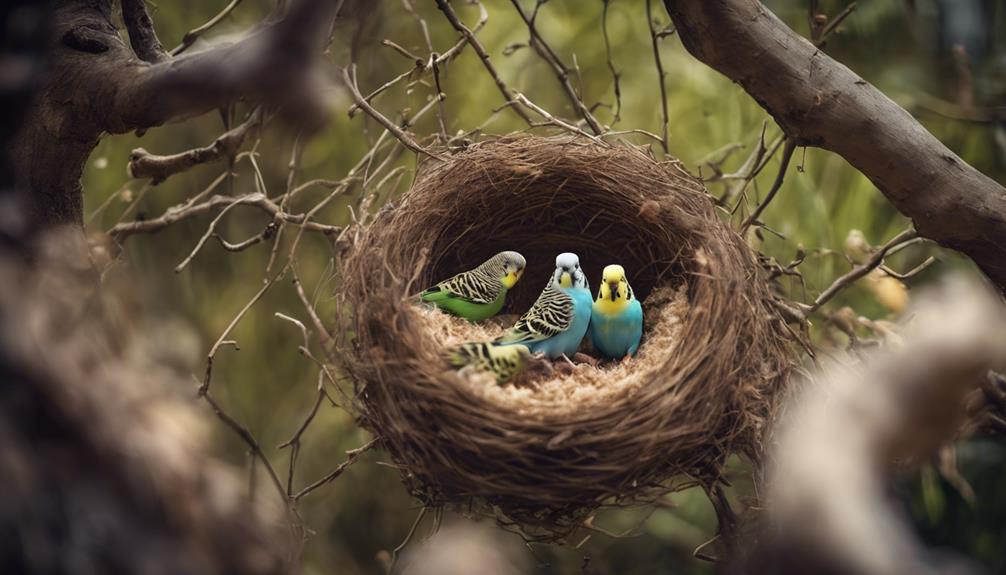
Budgerigars exhibit a range of nesting behaviors influenced by the type of nest available. Natural nesting materials like twigs, leaves, and feathers are commonly used by budgies in the wild.
However, in captivity, artificial nest options such as wooden nest boxes or coconut shells are provided to simulate a natural nesting environment for these birds.
Natural Nesting Materials
When selecting natural nesting materials for their nests, budgerigars demonstrate a preference for specific textures and types of materials that cater to their instinctual nesting behaviors. Budgies often opt for softer, more pliable materials that can be easily manipulated and molded into a comfortable nest structure. Natural materials like feathers, dried grasses, and coconut fibers are commonly chosen by budgerigars due to their availability in the wild and their ease of use in nest-building. These materials provide insulation and cushioning for the eggs and chicks, promoting a safe and warm environment for the budgie family. Below is a table highlighting some common natural nesting materials preferred by budgerigars:
| Material | Description | Benefits |
|---|---|---|
| Feathers | Soft and insulating | Provides warmth and comfort |
| Dried grasses | Flexible and easy to manipulate | Offers cushioning for eggs and chicks |
| Coconut fibers | Plentiful and pliable | Helps in nest structuring |
Artificial Nest Options
In considering artificial nest options for budgerigars, researchers have observed a variety of structures that mimic natural nesting environments to cater to the birds' instinctual behaviors. These options provide nesting alternatives that can be beneficial for budgies' breeding and comfort.
Here are some common types of artificial nests and their benefits:
- Wooden Nest Boxes: Sturdy and provide a natural feel for budgies.
- Plastic Nest Boxes: Easy to clean and sanitize.
- Coconut Fiber Nests: Mimic natural fibers, promoting nesting behavior.
- DIY Nesting Options: Allows customization and creativity in designing nests.
Each of these nesting accessories offers unique benefits to accommodate the diverse needs of budgerigars during their nesting period.
Nesting Material Preferences

Preference for nesting material in budgerigars is influenced by their natural instincts and environmental conditions. When providing nesting material alternatives, it's essential to consider the budgies' preferences. Budgerigars have been observed to favor softer materials like grass, hay, or shredded paper to construct their nests. These materials mimic the natural vegetation they'd use in the wild. During the nesting season, tips suggest offering a variety of materials to allow budgies to choose according to their preferences.
Nesting behavior observations indicate that budgies may show preferences for specific materials by actively selecting and arranging them in their nests. If budgies show signs of disinterest in the provided materials, modifications can be made by introducing new options to stimulate their nesting behavior positively. Understanding these preferences and making adjustments accordingly can help create a comfortable and suitable environment for budgerigars to engage in their natural nesting behaviors. By catering to their material preferences, caregivers can support budgies in expressing their natural instincts and behaviors effectively.
Signs of Nesting Behavior

Budgerigars exhibit nesting behavior through distinct observable signs such as changes in their daily routines and interactions. These signs provide valuable insights into their nesting preparation and behavior observation.
Here are four key indicators to look out for:
- Increased Shredding Activity: Budgies may begin shredding paper, fabric, or other materials more actively than usual, indicating a readiness to build a nest.
- Territorial Behavior: A budgie displaying heightened territorial tendencies, such as being protective of a specific area in the cage, is likely preparing for nesting.
- Exploration of Enclosed Spaces: When budgerigars show a keen interest in exploring enclosed spaces within their environment, like boxes or small crevices, it signals nesting cues.
- Feathering Gathering: Observing budgies collecting an unusual amount of feathers or soft materials in their beaks suggests they're getting ready to construct a cozy nest.
Nesting Challenges to Watch For
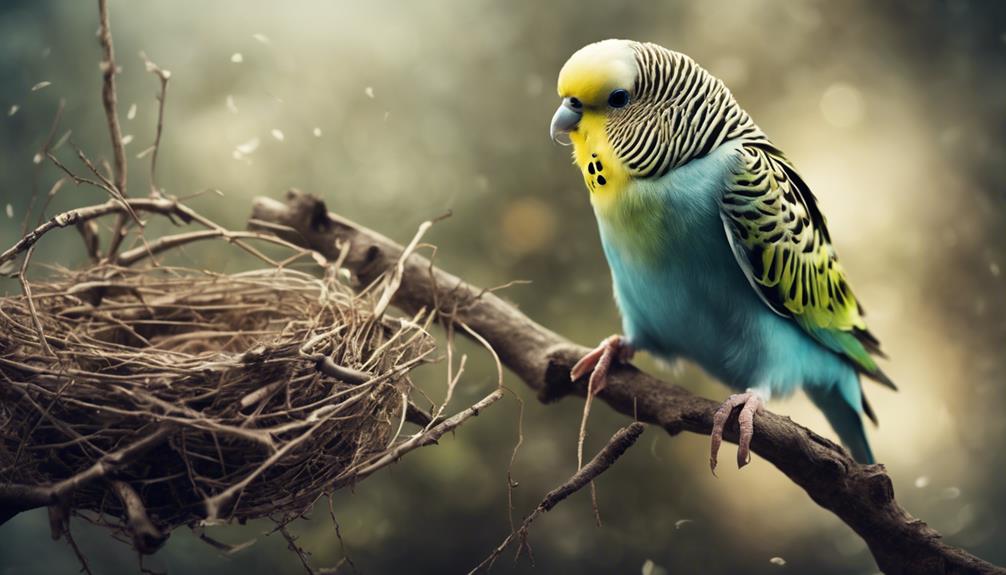
Observing budgerigars as they prepare to nest can unveil various challenges that may arise during the nesting process. Nesting challenges can stem from environmental factors such as temperature fluctuations, humidity levels, and noise disturbances. Budgies may exhibit behavioral observations like increased aggression towards mates or nest-box rejection when faced with unfavorable environmental conditions. These challenges can impact nesting success by causing stress to the birds, leading to decreased egg production or even abandonment of the nest.
Additionally, nesting challenges may arise from inadequate nesting materials or insufficient space within the nesting area. Budgerigars require specific materials like wood shavings, paper strips, or coconut fibers to build a suitable nest. Lack of these materials can hinder the nesting process and lower the chances of successful egg incubation. Furthermore, limited space within the nest box can lead to overcrowding, resulting in conflicts between budgies and potential harm to the eggs or chicks.
Understanding these nesting challenges and addressing them promptly is crucial for ensuring the well-being and reproductive success of budgerigars in captivity.
Creating a Safe Nesting Environment
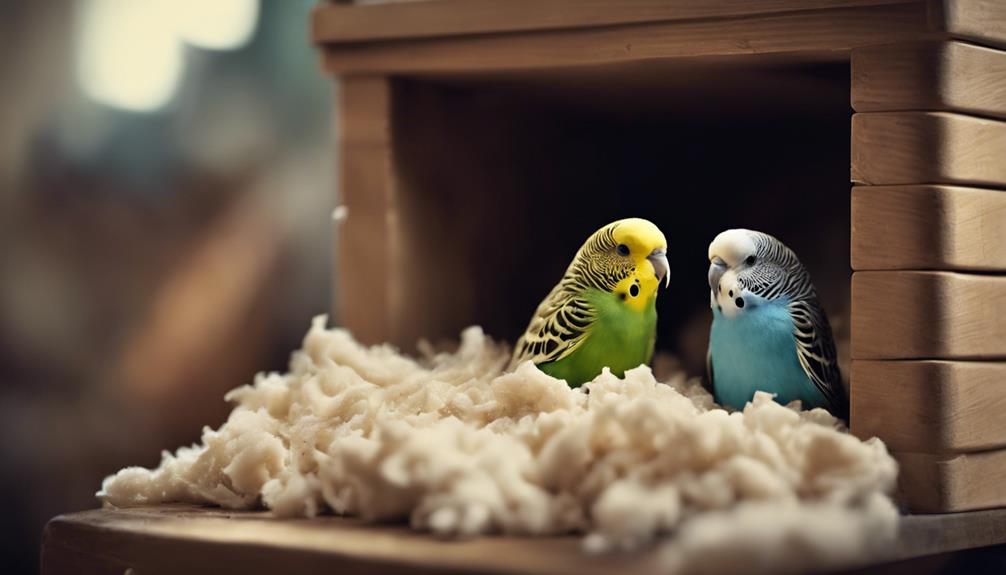
Budgerigars require specific nesting materials to create a safe environment for breeding. Careful selection of materials such as shredded paper, dried grass, or untreated pine shavings is crucial for the health and comfort of the birds.
Additionally, placing the nest box in a quiet and secure location within the cage can help minimize stress and disturbances during the nesting period.
Nesting Material Selection
Selecting appropriate nesting materials is crucial for budgerigars to create a safe and comfortable environment for breeding and raising their offspring. The choice of nesting material significantly impacts the well-being of the budgies and their chicks.
Here are some key considerations for selecting the best nesting materials:
- Natural Fiber Bedding: Ideal for budgies to build cozy nests.
- Paper-Based Substrate: Provides a soft and warm environment for nesting.
- Untreated Pine Shavings: Helps in absorbing moisture and maintaining cleanliness.
- Coconut Fiber: Mimics natural nesting materials, promoting a sense of security for the budgies.
Nest Box Placement
When considering Nest Box Placement for budgerigars, ensuring a safe and secure environment is paramount for successful breeding and chick rearing.
The Nest box design should include a small entrance hole to prevent larger predators from accessing the nest. Placing the nest box at a suitable height, around 5-7 feet above the ground, can provide the budgies with a sense of security while also mimicking their natural nesting preferences.
Additionally, the Nest box size should be spacious enough to accommodate both the breeding pair and their chicks comfortably. A recommended size is about 6-8 inches square and 12-15 inches high.
Breeding Considerations for Budgies
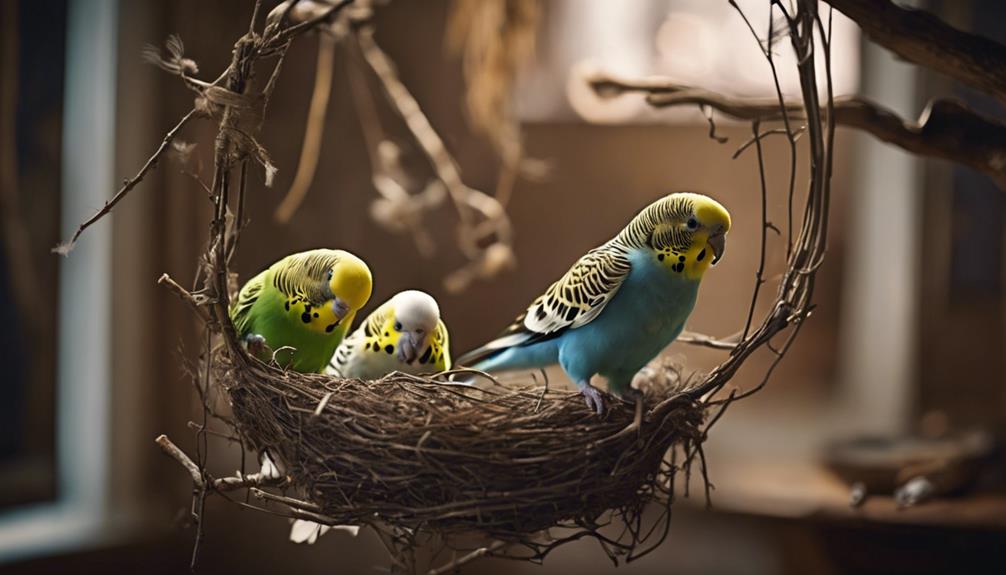
Breeding budgerigars involves carefully considering factors such as age, health, and genetic diversity to ensure successful reproduction. When preparing to breed budgies, several critical considerations come into play:
- Breeding Season Considerations: Budgies are more likely to breed during specific seasons when daylight lengthens, usually in spring and summer. Adjusting light exposure can help stimulate breeding behavior.
- Nesting Habits: Understanding the natural nesting habits of budgies is crucial. Providing appropriate nesting materials like shredded paper or coconut fiber can encourage breeding pairs to build nests.
- Breeding Pair Compatibility: Pairing budgies with compatible temperaments is essential for successful breeding. Observing their interactions beforehand can help identify potential issues.
- Nest Box Size: The size of the nest box is crucial for budgie breeding. It should be large enough to provide space for the pair and potential chicks while ensuring security and comfort.
Considering these factors thoughtfully can increase the chances of successful budgerigar breeding and the health of the offspring.
Frequently Asked Questions
How Can I Encourage My Budgie to Start Nesting?
Promptly present proper nesting materials, like paper strips or hay, placed near the cage. Persistently provide a warm, dimly lit environment. Preclude disturbances. Patience is paramount. Propagate their comfort by offering nutritious foods to inspire nesting behaviors in your budgie.
Is It Normal for Budgies to Exhibit Territorial Behavior During Nesting Season?
During nesting season, budgies may exhibit territorial behavior due to their instinctual nesting habits. This can include aggression towards perceived threats to their chosen nesting area. Mating rituals often involve displays of dominance as they establish breeding pairs.
Can Budgies Be Trained to Use a Specific Type of Nesting Material?
Like teaching a bird to sing, budgies can be trained to use specific nesting materials. By understanding their nesting preferences and consistent training, budgie owners can guide their pets to select suitable materials for nesting.
Are There Any Health Risks Associated With Allowing My Budgie to Nest?
Allowing a budgie to nest can pose health risks. Precautions include monitoring breeding behavior, ensuring a clean environment, and providing proper nutrition. Breeding consequences may lead to stress, egg binding, or aggression. Consult a vet for guidance.
How Long Does the Nesting Process Typically Last for Budgies?
The nesting process for budgies typically lasts around 2-4 weeks. Factors like environmental conditions and breeding success can influence this duration. Understanding these habits can help create a suitable nesting environment for these feathered companions.











